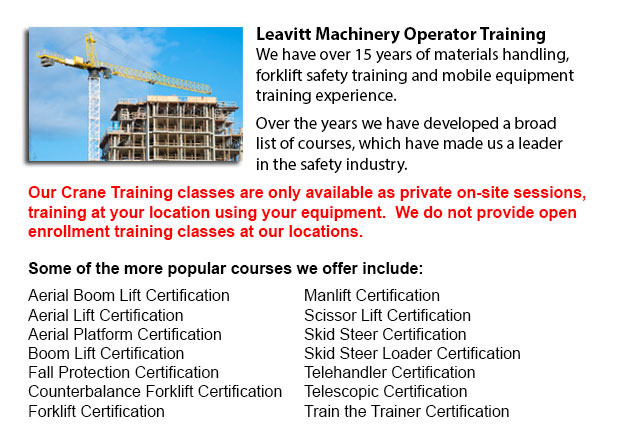
Overhead Crane Training Oakville - An overhead crane is a huge crane used to lift and move huge, heavy stuff that can't be lifted by hand. An overhead crane is typically fixed in place while in use. These machinery are capable of moving huge volumes of objects. Overhead cranes are normally made use of within steel mills to handle the steel throughout the fabrication process. These cranes are found at ports throughout the world, moving stuff off and on ships.
Overhead cranes are made to have a rail or beam permanently fixed on a support structure. A crane could be built right into a structure. Alternatively, a platform could be constructed to hold the beam in place. The fixed design of overhead cranes gives them great stability, that enables them to handle the really heavy loads needed in heavy businesses like shipping and steel. Several kinds of mobile overhead cranes are designed to be pulled by large motor vehicles.
The controls of an overhead crane are accessed via a device which is mounted on a trolley, running along the rail. The overhead crane is limited to running back and forth only. Things are lifted and lowered by running rope or cable through the mechanism mounted on the trolley, and then horizontally moved along the rail. This back and forth motion is sufficient. Like for example, at a port, a container ship is located near the crane, and the operator of the crane sends the mechanism back and forth along the trolley to shuttle goods between a train or truck and the ship. Jib cranes are a lot more flexible and have swinging booms for moving supplies in multiple directions.
The history of the overhead crane started in the eighteen seventies, when numerous designs were developed for a variety of uses. Smaller overhead crane models likewise exist for use in businesses where heavy things need to be lifted. A home workshop, for instance, might need the use of an overhead crane in order to transport lumber, finished products and tools between the workshop and loading area. Regardless of the use, overhead cranes must only be operated by individuals who have received overhead crane training.
-
Order Picker License Oakville
Order Picker License Oakville - Order preparation operation or order picking as it is more normally known is a method used within warehouse operations and consists of employees called order pickers. The order picker's task is to collect and take arti... More -
Forklift Operator Certification Oakville
Forklift Operator Certification Oakville - Forklift operator certification is normally needed for personnel working within industrial, warehouse or construction setting to guarantee the safe utilization of forklifts. Workplace training need to follow... More -
Scissor Lift Certification Oakville
Scissor Lift Certification Oakville - A lot of worksites and tradespeople like iron workers, welders and masons utilize scissor lift platforms to help them reach elevated work areas. The utilization of a scissor lift is usually secondary to their tra... More -
Forklift Training Courses Oakville
Forklift Training Courses Oakville - When forklift operator safety training is customized for illiteracy, training time is reduced by 50%. Train the trainer, forklift training certification and lift-truck operator driver safety training evaluation pr... More -
Manlift Training Oakville
Manlift Training Oakville - There are numerous manlift training programs which offer a review of the manlift machinery. The practicum portion of the training is one more vital portion of the course. In this section the trainee has chance to demonstra... More -
Boom Lift License Oakville
Boom Lift License Oakville - To operate an aerial boom lift, operators should be licensed through training that can be obtained utilizing both classroom sessions and practical training and by attaining a boom lift license. Instruction should be given... More -
Crane / Overhead Crane / Self-Erect Crane / Truck Mounted Crane / Hydraulic Cranes Training in Oakville
Bridge cranes or likewise called overhead cranes are actually a type of industrial material handling crane using a line and hook mechanism that runs on a horizontal beam running along two widely separated rails. Several overhead cranes could be seen... More -
Telehandler Training in Oakville
Telescopic handlers normally called telehandlers for short, are an extremely popular piece of heavy construction machinery. They are widely utilized in the construction and agricultural trades. These machines have maximum reaching ability and could g... More

Forklift Training Oakville
TOLL FREE: 1-888-254-6157
Oakville, Ontario
forklifttrainingoakville.com
Email Us
About Us


